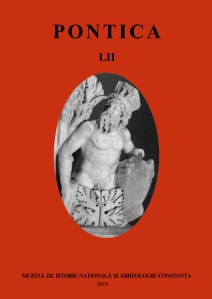Despre un tezaur din colecția numismatică a Muzeului Național Brukenthal
On a Hoard from the Numismatic Collection of the National Museum Brukenthal
Author(s): Gabriel Talmațchi, Claudiu MunteanuSubject(s): History, Anthropology, Social Sciences, Archaeology, Cultural history, Economic history, Local History / Microhistory, Ancient World
Published by: Muzeul de Istorie Națională și Arheologie Constanța
Keywords: siliqua; treasure; mints; Roman Empire; limes; 4th c. AD; Dobrudja;
Summary/Abstract: The article aims to continue an old approach by which we aim to identi fyand publish from the collection of the Sibiu museum of isolated discoveries and treasures that come from Dobrudja for sure or with a certain probability. In the collection of the Bruckenthal National Museum in Sibiu there is a batch of 28 siliquas, belonging to the old numismatic collection. This information suggests that the treasure reached the museum's collection through a donation made before 1948. More precisely, even before the First World War. The analysis of this treasure or fragment of treasure starts from the beginning from the lack of certainty of its discovery in the Istro-Pontic province. Just as,perhaps, we could hypothetically speak of a treasure returned to Dobrogea, which could have been discovered somewhere near the limes or in one of its fortifications. The money paid to the army facilitated the trade nearby the frontier. A number of 18 pieces belong to Constantius II, of which 12 are issued in Constantinople, 3 in Nicomedia, 2 in Sirmium and one still unassigned. All these specimens are of the VOTIS/XXX/MVLTIS/XXXXtype and belong to the years 355-361 AD. Three siliquas belong to Iulianus. One(VOT/X/MVLT/XX type) is issued in Constantinople (reduced, dated in the first half of363 AD), another (VICTORIA-DD NN AVG type) in Lugdunum (in 360-361 AD) and the last one (VOTIS/V/MVLTIS/X type) in Arelate (or Constantia) in 360-361 AD. The currency for Valentinian I (4 pieces) are issued in Constantinople (3 of the VOT/V,VOTIS/XXX/MVLTIS/XXXX, VOT/V/MVLT/X type, from 364-367 and 368-373 AD) and Nicomedia (one piece of VOT/V/MVLTIS/X type, from 367-373 AD). The three siliquas issued for Valens in Lugdunum (Restitutor Reipublicae type from 365-367 AD),in Aquileia (VOTIS/X/MVLTIS/XX type from 375-377 AD) and in Antiochia(VOT/XX/MVLT/XXX type from 375-378 AD). In Barbaricum we know that in the4th century AD. such discoveries appear mainly in the cultural space Sântana de Mure ș-Cerneahov, being associated with the Gothic ethnic presence.
Journal: Pontica
- Issue Year: 2019
- Issue No: 52
- Page Range: 319-332
- Page Count: 14
- Language: Romanian

